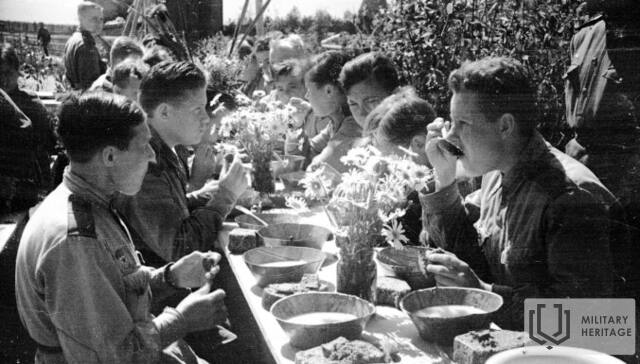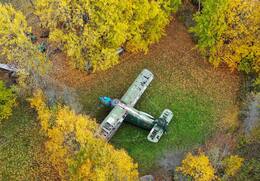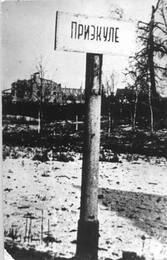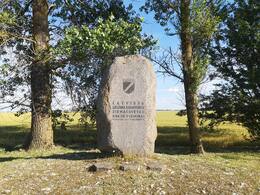Jūlijaus Bērziņšo liudijimas apie 201-ąją (43-iąją gvardiją) Raudonosios armijos latvių šaulių diviziją 1942-1945 m.

2011 m. rudenį į rankas pamačiau Rusijoje gyvenančio latvio, buvusio 201-osios (43-osios gvardijos) Latvijos šaulių divizijos (toliau – 201-oji latvių šaulių divizija; divizija) kario Jūlijaus Bērziņa (1900–po 1963 m.) prisiminimai apie 18-osios Latvijos karių parduotą Raudonosios armijos istoriją. Vokiečių ir SSRS karas (1941–1945) parašytas ranka į dvi sąsiuvinius rusų kalba. Šie prisiminimai taip pat nebuvo užsakomieji darbai.
130-asis latvių šaulių korpusas 1944 metų gruodžio 23–28 dienomis kovėsi Džūkstės mūšyje prieš Latvių legiono 19-ąją diviziją. Gruodžio 31-ąją sekė mūšiai Kārmači apylinkėse, vėliau 1945-ųjų vasarį – mūšiai prie Zvārdės, o 1945-ųjų kovą į atsargą pateko 130-asis latvių šaulių korpusas. Jis buvo sutelktas Blīdenėje (netoli Saldus) ir platesnėje vietovėje, kur kovo mėnesį vykdavo reguliarūs mūšiai. Reikia pažymėti, kad kovo 4 dieną prasidėjusį Blīdenės mūšį galima apibūdinti kaip „daužymą kakta į sieną“. Tęsėsi tai, kas jau buvo prasidėjusi 1941 m. gruodį per Maskvos mūšį – latvių kariai buvo paskirti kautis beveik beviltiškame fronto sektoriuje. Mūšis prie Blīdenės truko mėnesį.
1945 m. gegužės 8 d. – tą dieną, kai baigėsi karas, Imulos upės pakrantėje įsikūrė 130-asis latvių šaulių korpusas.
1947 m. kovą divizija buvo pertvarkyta į 29-ąją atskirąją gvardijos latvių Rygos šaulių brigadą, 1950 m. birželį – į 43-iąją gvardijos latvių šaulių Rygos diviziją, tačiau 1956 m. gegužės–birželio mėn. divizija ir jos daliniai buvo išformuoti.
Tiesą sakant, visas 201-osios latvių šaulių divizijos kautynių laikotarpis pasižymėjo ir vadų trūkumu, dideliais personalo praradimais mūšio laukuose ir vėlesniais sunkumais juos papildant, ypač latvių kariais. Tai kardinaliai pakeitė tautinę divizijos sudėtį, sukėlė divizijos vadų, ypač Veikino, nepasitenkinimą.
JULIA BĒRZINĀS ASMENYBĖ
Vienintelis informacijos šaltinis apie Jūlijaus Bērziņšo asmenį yra tai, ką jis apie save pasakoja savo atsiminimuose. Jūlijs Bērziņš – Rusijos latvis, tikriausiai gimęs Nižnij Novgorod (1932–1991 m. Gorkis), kur gyveno iki šaukimo į 201-ąją latvių šaulių diviziją. Greičiausiai jis gimė Latvijoje ir 1914 m., prasidėjus Pirmajam pasauliniam karui, evakuotas į Rusiją. Gimė 1900 m. Dalyvavo Rusijos pilietiniame kare, tačiau nežinoma, kiek laiko ir kokiame fronto sektoriuje. Prieš prasidedant Vokietijos ir SSRS karui, dirbo Gorkyje Vandens ir kanalizacijos tresto ekonomikos skyriuje buhalteriu. 1942 05 25 pašauktas į Raudonąją armiją, išsiųstas į 1-ąjį atskirąjį latvių šaulių atsargos pulką, o baigęs mokymus įstojo į kulkosvaidžių kuopą į 1-ąjį bataliono 191-ąjį pulką, 201-ąją latvių šaulių diviziją. Iki 1943 m. pavasario Bērziņš turėjo eilinio laipsnį, o per karą jis galėjo būti paaukštintas, nes jo atsiminimuose minima, kad karo pabaigoje jis buvo amunicijos tiekimo (būrio) vadas. Iš atsiminimų neaišku, ar jis 1937–1938 m. per represijas Rusijoje 2001 m., to nepatvirtina ir SSRS politinio teroro metu suimtųjų ir nubaustų duomenų bazės. Apie galimą Bērziņšo ryšį su represijomis byloja atviras 1937–1938 m. atsiminimų pobūdis. Metų įvykių ir pasekmių kritika.
1942 m. rugsėjį per Tuganovos mūšį Bērziņš buvo sužeistas, po to tris mėnesius praleido karo ligoninėse, kol tų pačių metų gruodžio 15 d. vėl atsidūrė Gorohoveco stovykloje 1-ajame atskirame Latvijos šaulių atsargos pulke. Po mokymų 1943 m. kovo pabaigoje grįžo į 201-ąją latvių šaulių diviziją, šį kartą į 121-ąjį gvardijos latvių šaulių pulką. Ten tarnavo ir kulkosvaidininkų kuopoje, ir buvo perkeltas (dėl amžiaus) į ūkio būrį, kuriame tarnavo iki karo pabaigos. Po karo gyveno Maskvoje.
Atsiminimus jis pradėjo rašyti 1942 m. birželį ir, nors minimi tik 1942 ir 1943 metai, autorius aptaria ir 1944 ir 1945 metų išgyvenimus. Bērziņš rašo ne tik apie įvykius, kurių dalyvis pats buvo, bet ir pateikia praeities vertinimą. Sunku spręsti, ar autorius turi fenomenalią atmintį, ar naudoja geras knygas, tačiau kartais jis pateikia išsamių įžvalgų apie skirtingus Rusijos istorijos etapus.
Prisiminimai – tai naujas, anksčiau neskelbtas liudijimas apie 201-ąją latvių šaulių diviziją ir tai, ką jie matė kare. Atsiminimų vertę nulemia apskritai objektyvūs autoriaus sprendimai (jie gali būti nustatomi greta informacijos kituose šaltiniuose, įskaitant oficialius dokumentus) ir detalės, kurios papildo atskirus įvykius ir nėra aptinkamos kituose šaltiniuose. Atsiminimai pateikia bendrą vaizdą apie padėtį divizijoje, kai karo baigtis jau buvo žinoma. Tai rodo autoriaus vertinimai apie įvykius praeityje arba kokių veiksmų reikėjo imtis, kad rezultatas būtų kitoks.
Šiam leidiniui atrinkti ir išversti atrinkti Bērziņšo prisiminimų fragmentai. Dalys, apibūdinančios „sausus“ karinius įvykius, neįtrauktos, tačiau įtraukiamos tos, kurios leidžia sekti „gyvo“ kario pastebėjimus santykiuose: karys – vadas, karys – kiti kariai, karys – pareigos, karys – įvykiai.
Ilze Jermacāne "Julijos Berzins liudijimas" LVIZ 2012 m
https://www.lvi.lu.lv/fileadmin/user_upload/lu_portal/lvi.lu.lv/LVIZ_Numuri/2012_2/I_Jermacane_Julija_Berzina_liecibas_LVIZ_2012_2.pdf
„Latviai nuo kulkų nesikrato“ – ką žinome ir nežinome apie latvius Raudonojoje armijoje – DELFI
https://www.delfi.lv/kultura/news/books/latviesi-lodem-neklanas-ko-mes-zinam-un-nezinam-par-latviesiem-sarkanaja-armija.d?id=53232121
Jūsų komentarai
Susijusios vietos
Kurzeme fortress museum in Zante
The museum exposition (the only museum dedicated to the Kurzeme fortress) tells richly and engagingly about the course of warfare in the Kurzeme fortress and the future fates of Latvian soldiers. On the other hand, in the open-air exhibition, you can walk around and see the restored wartime trenches, bunkers and heavy military equipment.
Working hours:
Monday - Tuesday - closed
Wednesday - Saturday - 10:00 - 17:00
Sunday - 10:00 - 15:00
It is advisable to contact in advance by phone 29442311.
Memorial Stone to Defenders of the Kurzeme Fortification
Located in Tukums region, on the side of the A9 motorway, 500 m from the turn to Lesteni in the direction of Riga.
The memorial site was established in 1991 near the Rumbu houses, in the vicinity of which there was active warfare. This is a tribute to the defenders of the "Kurzeme Fortress" who fought against the Red Army in World War II. The battles were significant because they temporarily stopped the Red Army's complete occupation of Latvia. About 300,000 Latvians emigrated, avoiding crimes against the civilian population by the Soviet regime.
At the end of World War II, a peculiar situation had developed in the territory of Latvia. There were German army forces in Kurzeme, which the Red Army tried to eliminate or prevent their involvement in the fighting in East Prussia or around Berlin. "Kurzeme Fortress" - the most common term to describe the warfare in Kurzeme from 1944 to 1945. The "battles of Kurzeme" were the battles of the German army to repel the large-scale attacks of the Red Army. The Kurzeme fortress ceased to exist shortly after the German capitulation.
Today you can see a place of remembrance and rest, which has been popular among Latvian legionnaires since the restoration of Latvia's independence.
Monument to Victims of the Christmas Battles in Pienava
Located in Tukums region, on the side of the A9 motorway, about a kilometer behind Pienava in the direction of Liepaja.
The memorial is erected on the site of the Third Battle of Kurzeme or the Christmas battles in 1944. At the end of World War II, a peculiar situation had developed in the territory of Latvia. There were German army forces in Kurzeme, which the Red Army tried to eliminate or prevent their involvement in the fighting in East Prussia or around Berlin. "Kurzeme Fortress" - the most common term to describe the battles in Kurzeme from 1944 to 1945. The "battles of Kurzeme" were the military action of the German army to repel the large-scale attacks of the Red Army. Latvian legionnaires also took an active part in the fighting in Kurzeme.
Today you can see the memorial site. The open countryside without the oldest buildings is a witness to the war.









Apskritai, yra jausmas, kad yra daug prasimanymų ir visokių importinių dalykų, tokių kaip gandai ir panašiai, kurie atsirado po permainų 90-ųjų pradžioje, kai jau formavosi neigiamas požiūris į sovietinę praeitį. Tokiuose prisiminimuose nematau jokios vertės. Tačiau 43-iosios latvių divizijos istorija mane labai domina. Mano tėvas Buikis Peteris skyriuje buvo nuo pat jo formavimo pradžios ir tarnavo iki 1945 m. pabaigos. Paskutinius 2 metus ėjo pavaduotojo pareigas. skyriaus vadas logistikai, t.y. divizijos logistikos vadovas. Aš pats, būdamas 8 metų, buvau tėvo skyriuje Baltezers-Adažyje. Gerai prisimenu, kaip buvo demobilizuojami kariai. Sužeistieji dar buvo gydomi medikų batalione ir kt.